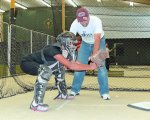By "intended flight path" I assume you mean pitch?
It's foul balls that are the threat to the throwing hand. I still say behind the glove is the safest spot, or at least that is what Dave Weaver spent 15 minutes explaining and convincing me.
Yes, I mean pitch.
Catching is a lot like pitching, each has their own style and what works best for them I guess you could say. That's why I posted the video, even top paid catchers are not all the same in mechanical stances.





